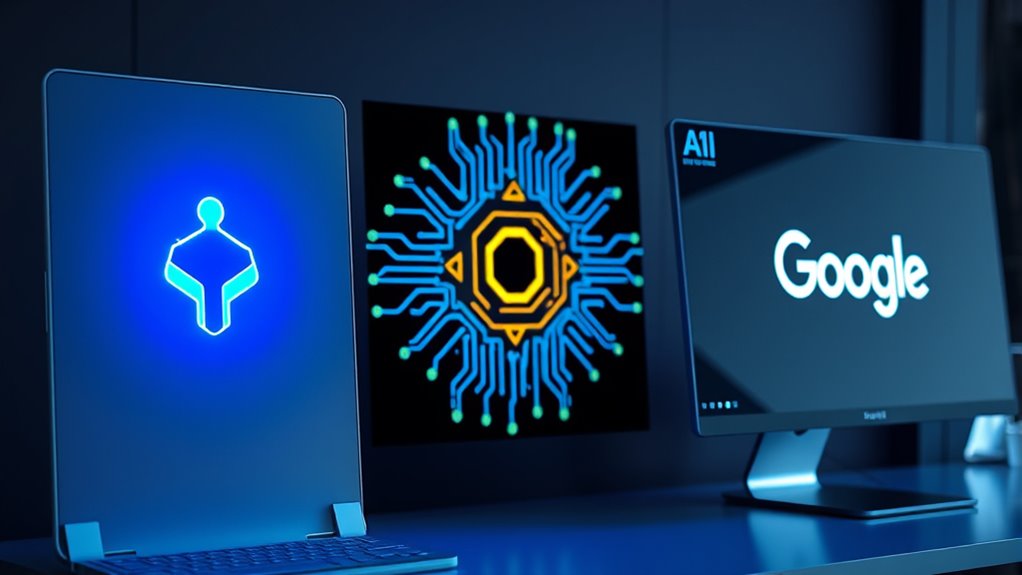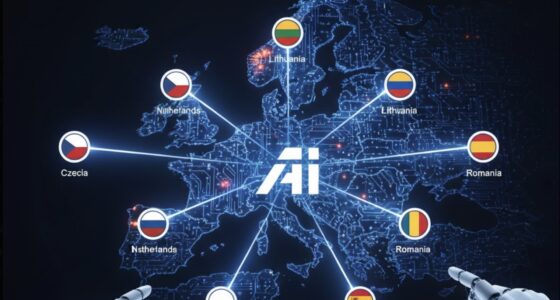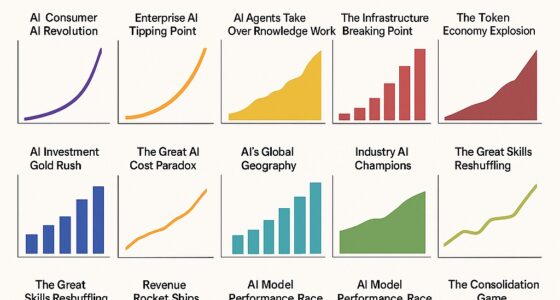If you compare Anthropic, OpenAI, and Google, you’ll find each has a distinct approach. Anthropic focuses on safety, interpretability, and specialized enterprise solutions. OpenAI balances capability with safety, making AI accessible through APIs and partnerships. Google emphasizes seamless integration into its products and infrastructure, aiming for broad adoption. Understanding these key differences helps you decide which company’s philosophy aligns best with your goals—keep exploring to gain deeper insights.
Key Takeaways
- OpenAI emphasizes versatility and broad accessibility through APIs and partnerships, balancing capability with safety.
- Anthropic prioritizes safety and interpretability, deploying models like Claude with constitutional AI for high safety and transparency.
- Google focuses on seamless integration into its ecosystem, embedding AI into products and infrastructure for widespread adoption.
- Performance benchmarks show Google Gemini excelling in coding and reasoning, while OpenAI’s GPT-3.5 Turbo balances versatility and accuracy.
- Each company’s core philosophy—openness (OpenAI), safety (Anthropic), and integration (Google)—shapes their AI development and deployment strategies.
Core Philosophies and Design Principles
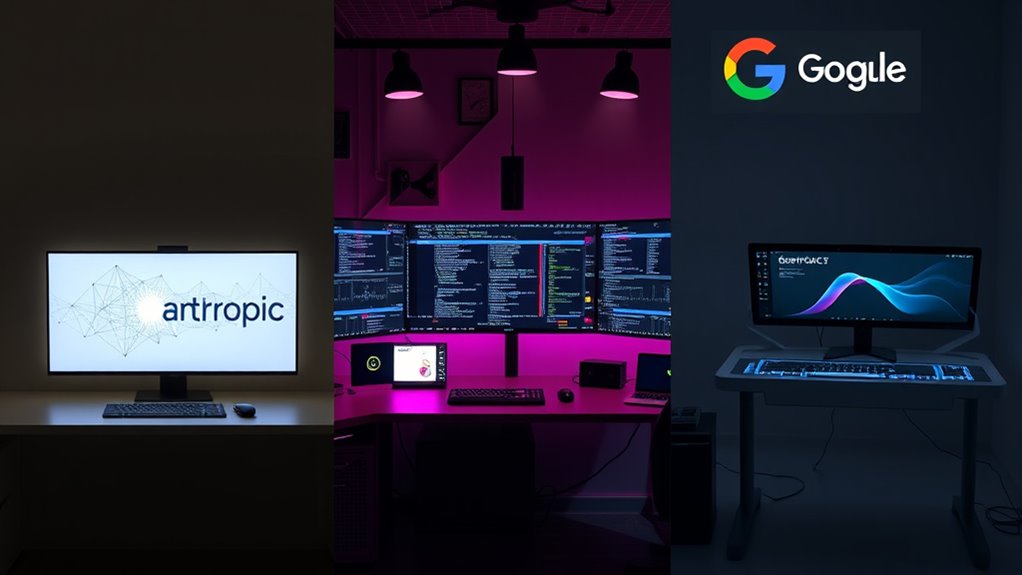
Understanding the core philosophies and design principles of AI companies is essential because these foundations shape how their models behave and serve users. If you work with OpenAI, you’ll notice their focus on creating versatile, human-like interactions through multimodal capabilities and reinforcement learning from human feedback. Anthropic, on the other hand, emphasizes safety and interpretability, designing models like Claude to promote predictable, aligned outputs, especially in sensitive contexts. Google integrates AI deeply into its infrastructure, aiming for seamless embedding within products and services. Your experience with these models depends on these principles—OpenAI balances raw capability with safety, Anthropic prioritizes safety and transparency, while Google emphasizes infrastructure integration. These philosophies guide their development and determine how you interact with their AI systems. Additionally, the specific model types they develop influence the scope and safety features of AI applications.
Market Strategies and Adoption Patterns
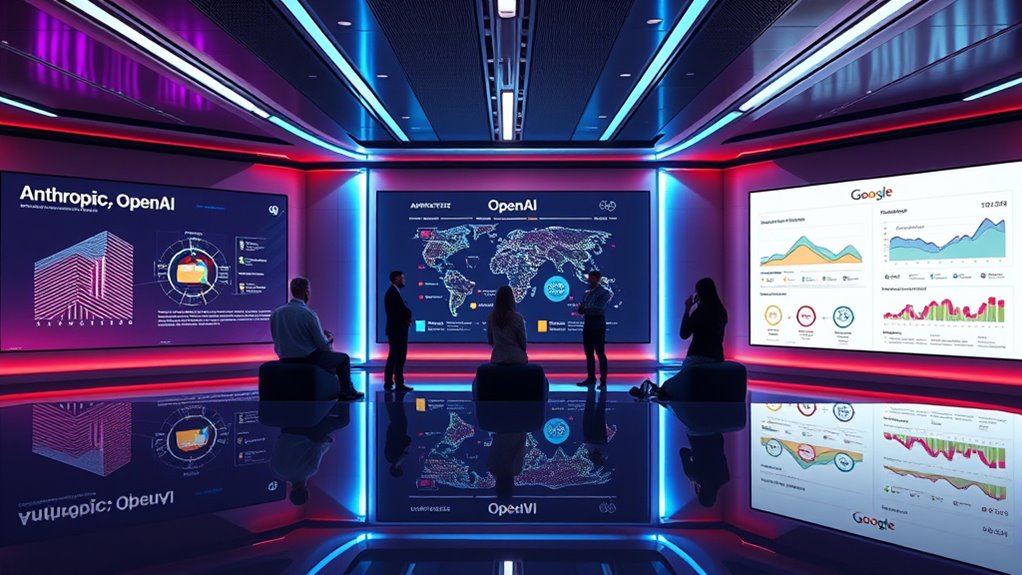
Market strategies and adoption patterns vary considerably among AI giants, shaping how their technologies reach users and industries. OpenAI prioritizes broad accessibility through its API ecosystem, partnering with major cloud providers like Microsoft Azure to embed its models across various applications. This approach fosters rapid adoption among developers and enterprises, with tiered pricing to suit different needs. Anthropic concentrates on high-safety, specialized markets, offering enterprise APIs designed for sensitive industries like government and healthcare. Its adoption pattern is more cautious, emphasizing compliance and safety standards. Google integrates AI deeply into its product ecosystem, embedding models into tools like Google Workspace and Cloud, promoting seamless adoption among developers and consumers alike. These strategies reflect each company’s focus: openness, safety, or integration, shaping their respective market footprints. Additionally, the market adoption patterns are influenced by each company’s engagement with regulatory environments and safety standards, which play a crucial role in their growth strategies.
Performance Benchmarks in Coding and Reasoning

Performance benchmarks in coding and reasoning reveal the distinct strengths of leading AI models like Google Gemini, Anthropic Claude, and OpenAI’s GPT series. You’ll notice Google Gemini 1.5 outperforms others on coding leaderboards, demonstrating senior developer-level reasoning in tasks like code refactoring. OpenAI’s GPT-3.5 Turbo excels in contamination-free benchmarks, delivering high accuracy in coding tasks and reasoning. Anthropic Claude has maintained strong performance among programmers, especially in complex reasoning scenarios, though recent advances from Gemini shift the landscape. Each model shows nuanced capabilities: Gemini shines in decision-making, Claude emphasizes safety and interpretability, and GPT balances versatility with accuracy. Additionally, understanding model shelf life and how updates impact performance can help users select the right AI for their needs. These benchmarks help you understand each model’s strengths and limitations, guiding your choices based on specific coding and reasoning needs.
Safety, Ethics, and Alignment Initiatives

Have you ever wondered how leading AI companies guarantee their models behave safely and ethically? Each company takes a different approach. Anthropic uses constitutional AI, embedding safety and interpretability directly into its models’ frameworks, assuring predictable and aligned outputs. OpenAI combines human-in-the-loop moderation with policy collaborations to oversee and mitigate risks like bias and misinformation. Both prioritize research into bias reduction and misuse prevention, actively working to improve safety standards. Google invests heavily in safety and alignment, integrating these efforts into its infrastructure-driven AI deployment. Transparency and principled ethics guide all three companies’ policies and product designs, aiming to build trust and ensure AI benefits society responsibly. Their initiatives reflect a shared commitment to balancing innovation with safety and ethical accountability. Additionally, ongoing developments in cybersecurity, such as improved eSIM security protocols, are crucial for safeguarding AI-related infrastructure and user data.
Ecosystem Development and Developer Engagement

Leading AI companies are actively shaping their ecosystems to make their models more accessible and user-friendly for developers. OpenAI leads with a broad API ecosystem that integrates seamlessly with major cloud platforms and supports various applications, from chatbots to coding tools. Its free and paid tiers encourage experimentation and deployment, ensuring widespread adoption. Anthropic focuses on enterprise clients, offering tailored integration support that emphasizes safety and compliance, appealing to regulated industries. Google leverages its extensive developer tools and cloud infrastructure to embed AI models into existing workflows, simplifying adoption across sectors. These companies foster vibrant communities by providing documentation, SDKs, and support channels, encouraging innovation. Their efforts drive engagement, expand the AI ecosystem, and enable developers to build more capable, safe, and integrated AI solutions. Additionally, they are investing in community engagement initiatives to foster collaboration and knowledge sharing among developers, which further accelerates ecosystem growth.
Frequently Asked Questions
How Do These Companies Handle Data Privacy and User Confidentiality?
You should know that these companies prioritize data privacy and user confidentiality differently. OpenAI uses strict data handling policies, offers options to opt out of data sharing, and employs privacy-preserving techniques. Anthropic emphasizes safety and compliance, often working with enterprise clients under confidentiality agreements. Google integrates privacy safeguards into its infrastructure, encrypts data, and follows rigorous data governance standards. All aim to protect your information while balancing innovation and usability.
What Are the Costs Associated With Each Company’s AI API Services?
You’ll find that OpenAI offers flexible API pricing with free tiers and paid plans, making it accessible for various users. Anthropic provides enterprise-focused pricing with additional safety and compliance features, typically tailored to client needs. Google’s API costs depend on usage and the specific service, often integrated into their cloud platform’s billing system. Overall, costs vary based on usage volume, feature complexity, and service tier you choose.
How Actively Do They Collaborate With Policymakers on AI Regulation?
You’ll find that all three companies actively collaborate with policymakers, but Anthropic leads with a strong focus on shaping regulation through transparency and safety initiatives. OpenAI also engages extensively, partnering with governments and organizations to develop responsible AI policies. Google participates considerably, integrating safety considerations into its infrastructure and advocating for standards. These collaborations aim to guarantee AI development aligns with societal values, though their emphasis varies based on their core philosophies and market roles.
What Are Their Strategies for Addressing AI Bias and Misinformation?
You should know that they actively work to reduce AI bias and misinformation through different strategies. Anthropic embeds safety and interpretability into their models with constitutional AI, making outputs more predictable. OpenAI uses human-in-the-loop moderation and policy collaborations to oversee content quality. Google focuses on building safety into infrastructure and deploying models responsibly. All three prioritize research, transparency, and partnerships to improve fairness, accuracy, and prevent misuse of AI systems.
How Do They Plan to Scale Their AI Models in the Next Five Years?
You might think scaling AI models is all about bigger servers, but these companies are betting on smarter growth. OpenAI will refine its models with better safety and accessibility, Anthropic will emphasize safer, more interpretable systems, and Google will embed AI deeper into its infrastructure for seamless integration. Over the next five years, they’ll innovate in efficiency, safety, and ecosystem expansion, proving size isn’t everything—just look at how fast they’re growing.
Conclusion
As you compare these AI giants, you’ll see Anthropic’s focus on safety, OpenAI’s rapid innovation, and Google’s integration into everyday tech. Did you know that GPT-4 surpasses 100 million active users within just a few months? This rapid adoption highlights how market strategies and safety priorities shape AI’s future. Staying informed about their evolving approaches helps you understand the tech shaping tomorrow’s world—so keep watching these key players closely.
